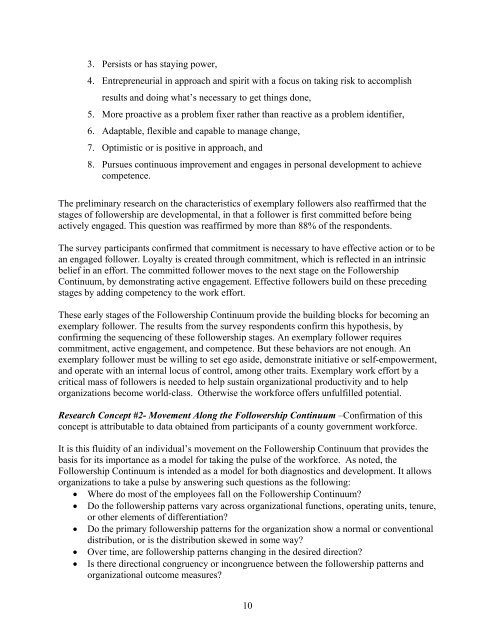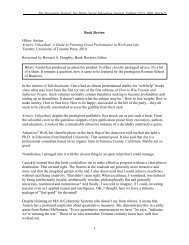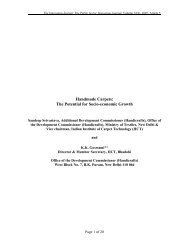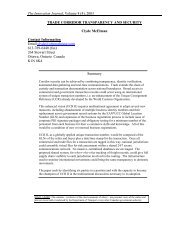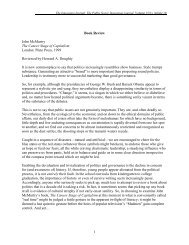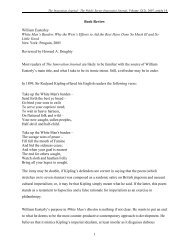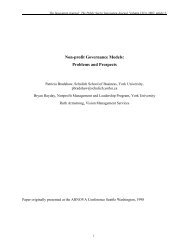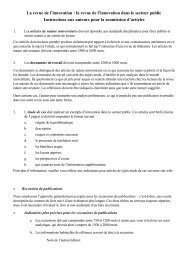The Followership Continuum - The Innovation Journal
The Followership Continuum - The Innovation Journal
The Followership Continuum - The Innovation Journal
Create successful ePaper yourself
Turn your PDF publications into a flip-book with our unique Google optimized e-Paper software.
3. Persists or has staying power,<br />
4. Entrepreneurial in approach and spirit with a focus on taking risk to accomplish<br />
results and doing what’s necessary to get things done,<br />
5. More proactive as a problem fixer rather than reactive as a problem identifier,<br />
6. Adaptable, flexible and capable to manage change,<br />
7. Optimistic or is positive in approach, and<br />
8. Pursues continuous improvement and engages in personal development to achieve<br />
competence.<br />
<strong>The</strong> preliminary research on the characteristics of exemplary followers also reaffirmed that the<br />
stages of followership are developmental, in that a follower is first committed before being<br />
actively engaged. This question was reaffirmed by more than 88% of the respondents.<br />
<strong>The</strong> survey participants confirmed that commitment is necessary to have effective action or to be<br />
an engaged follower. Loyalty is created through commitment, which is reflected in an intrinsic<br />
belief in an effort. <strong>The</strong> committed follower moves to the next stage on the <strong>Followership</strong><br />
<strong>Continuum</strong>, by demonstrating active engagement. Effective followers build on these preceding<br />
stages by adding competency to the work effort.<br />
<strong>The</strong>se early stages of the <strong>Followership</strong> <strong>Continuum</strong> provide the building blocks for becoming an<br />
exemplary follower. <strong>The</strong> results from the survey respondents confirm this hypothesis, by<br />
confirming the sequencing of these followership stages. An exemplary follower requires<br />
commitment, active engagement, and competence. But these behaviors are not enough. An<br />
exemplary follower must be willing to set ego aside, demonstrate initiative or self-empowerment,<br />
and operate with an internal locus of control, among other traits. Exemplary work effort by a<br />
critical mass of followers is needed to help sustain organizational productivity and to help<br />
organizations become world-class. Otherwise the workforce offers unfulfilled potential.<br />
Research Concept #2- Movement Along the <strong>Followership</strong> <strong>Continuum</strong> –Confirmation of this<br />
concept is attributable to data obtained from participants of a county government workforce.<br />
It is this fluidity of an individual’s movement on the <strong>Followership</strong> <strong>Continuum</strong> that provides the<br />
basis for its importance as a model for taking the pulse of the workforce. As noted, the<br />
<strong>Followership</strong> <strong>Continuum</strong> is intended as a model for both diagnostics and development. It allows<br />
organizations to take a pulse by answering such questions as the following:<br />
• Where do most of the employees fall on the <strong>Followership</strong> <strong>Continuum</strong>?<br />
• Do the followership patterns vary across organizational functions, operating units, tenure,<br />
or other elements of differentiation?<br />
• Do the primary followership patterns for the organization show a normal or conventional<br />
distribution, or is the distribution skewed in some way?<br />
• Over time, are followership patterns changing in the desired direction?<br />
• Is there directional congruency or incongruence between the followership patterns and<br />
organizational outcome measures?<br />
10


